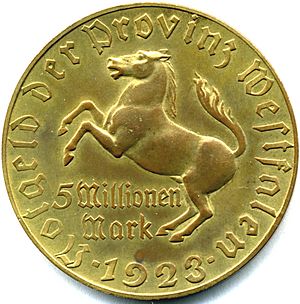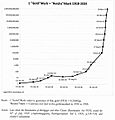Hyperinflation facts for kids
Hyperinflation happens when prices for goods and services increase super fast. It means that money quickly loses its value. Imagine if a candy bar cost $1 today, but $100 tomorrow! That's what hyperinflation feels like. It's a very serious problem in economics.
Contents
What is Hyperinflation?
Hyperinflation is a type of inflation that is "out of control." It means prices go up incredibly quickly. Your money becomes worth less and less almost every day. This makes it hard for people to buy what they need. It also makes it difficult for businesses to plan.
How Money Loses Value
When hyperinflation happens, the government might print a lot more money. This is often done to pay for things. But when there's too much money, it becomes less valuable. Think of it like this: if everyone suddenly had a million toys, each toy wouldn't feel as special or valuable anymore. The same thing happens with money.
Hyperinflation in Germany
One of the most famous examples of hyperinflation happened in Germany in the 1920s. After World War I, Germany had many debts. The government printed a lot of money to pay for things.
The German Mark Loses Value
- In 1922, the largest banknote was 50,000 Mark.
- By 1923, the largest banknote was 100,000,000,000,000 (100 trillion) Mark!
- In December 1923, you needed 4,200,000,000,000 (4.2 trillion) German Marks to buy just one US dollar.
People's money became almost worthless. They would use banknotes for unusual things. Sometimes, people would burn stacks of money in their stoves to keep warm. The paper money would burn longer than the amount of wood they could buy with it. Prices would sometimes double every two days!
Stopping the Crisis
To fix this huge problem, Germany introduced a new currency. It was called the Rentenmark. This new money helped to stabilize the economy. The exchange rate was set at 4.2 Rentenmarks to 1 US Dollar. This helped stop the hyperinflation.
Hyperinflation in Zimbabwe
Another recent example of hyperinflation happened in Zimbabwe. This was in the country of Zimbabwe in Africa. In July 2008, the inflation rate was extremely high. It reached 231,150,888.87% in just one month. This means prices were going up incredibly fast. People needed huge stacks of money to buy basic items.
Images for kids
-
In Germany, 1923, banknotes had lost so much value that they were used as wallpaper.
-
The 100 trillion Zimbabwean dollar banknote (1014 dollars).
See also
 In Spanish: Hiperinflación para niños
In Spanish: Hiperinflación para niños












